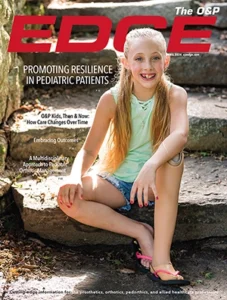September 29, 10:30 a.m.-noon
Osseointegration in the U.S.—Prosthetic Implications for Today and Tomorrow
Jeffrey Cain, MD
Christopher Hoyt, CP
Jason Stoneback, MD
This session will highlight the coming influx of patients curious about osseointegration (OI), how vital prosthetic care is to OI patients, and how OI care will be managed now and in the future.
Studies show people with OI have better osseoperception and can walk farther and longer compared to those wearing a traditional socket, but it is not suitable for every amputee. While OI can be transformative for some, patients must be prepared to make fully informed decisions, which includes relying on their prosthetist’s expertise about the risks and benefits.
The session will include information about how prosthetists can help patients choose their best options, and should OI be the best choice, the prosthetists and patients must know how OI prosthetic care differs from traditional devices. Since OI has no socket, correct prosthetic alignment, shock absorption, and rotation issues become even more critical to patients’ mobility and comfort.
Other topics for discussion will include how O&P associations can support the prosthetist’s role in OI care in the greater medical community.
As a physician with personal experience with OI, Cain says the next two years will see an explosion in patient interest and prosthetists need to be prepared. The session will include details about surgical considerations, rehab, complications, and costs, but the most important goal is to is to help prosthetists answer one question: Device manufacturers will be talking to patients, will prosthetists?
September 29, 10:30 a.m.-noon
Keeping Pace with Surgical Advancements—Partial Forms Play a Key Role
Margy J. Imlay, CFm, CMF
Rebecca E. Weldon-Martin, CFm, CMF
Rachel Brown, CFm
Alicia Correa, CMF
Moderator: Tanya Baer, CFom
In this panel discussion, the attendees will get to hear from several different viewpoints of industry insiders about the changes in post-mastectomy care and how our practices can change and evolve as well. The speakers will discuss how fittings can vary based on the patient’s individual needs. Attendees will also have an opportunity to join the discussion. The panel of experts in the postmastectomy care community will also discuss how the advancements in surgeries has created more challenging fittings for certified mastectomy fitters.
September 29, 3:30-5:00pm
Non-Invasive Measurements of Residual Limb Health: Current and Future Implications
Molly Baumann, PhD,
Jason Highsmith, PhD, PT, DPT, CP, FAAOP
Jason Kahle, MSMS, CPO, FAAOP
Matt Wernke, PhD
Residual limb skin health is a perpetual issue in prosthetic care. The symposium’s investigators will outline measurements of residual limb health Kahle and Highsmith have used in past clinical trials. The speakers will also share measurements they know about or would like the attendees to be aware of for future projects. The effects of socket design on perspiration, socket motion on skin health, distal pressure, and non-invasive measurement techniques will be discussed.
September 30, 10:30-11:15 a.m.
How to Navigate The World of Insurance Contracting and Coverage Deciphering
Tanya Baer, CFom
This session is an introduction to insurance contracting and coverage verification. Attendees will come away with an idea of where to start in the contracting process, and how that relates to seeing patients. They will be able to better understand how to read a patient’s insurance coverage and provide accurate information regarding reimbursement and financial responsibility.
October 1, 1-3 p.m.
Prosthetic Free Paper: Does Wearable Technology Improve Patient Outcomes? A Multi-Site, Randomized Clinical Trial
Jason Kahle, MSMS, CPO, LPO, FAAOP
Jason Highsmith, PhD, PT, DPT, CP, FAAOP
This prosthetic free paper details a clinical trial that wrapped up earlier this year, and Kahle and Highsmith, the co-principal investigators, are beginning to disseminate the results with this first presentation about the study. The trial’s intervention was a wearable socket sensor for patients with transtibial amputations that sensed distal pressure, and, using the patient’s smartphone, prompted the patient to make a socket adjustment, such as removing a sock to avoid skin or residual limb health issues. Remote patient monitoring and wearable technology allow clinicians to automate continual monitoring, and could improve outcomes.
Effectiveness of a Peer Visitation Program to Improve Patient Activation and Quality of Life During Amputation Rehabilitation: Randomized Clinical Trial
Jason Kahle, MSMS, CPO, LPO, FAAOP
In this poster presentation about his clinical trial, Kahle used the Amputee Coalition’s Peer Visitation program to compare effects of the program on depression, patient activation, overall health and quality of life. Aside from acting as principal investigator on many clinical trial grants, Kahle is a member of the Outcomes Research Committee of the American Academy of Orthotists and Prosthetists.
To see the full program, visit AOPA’s website.




